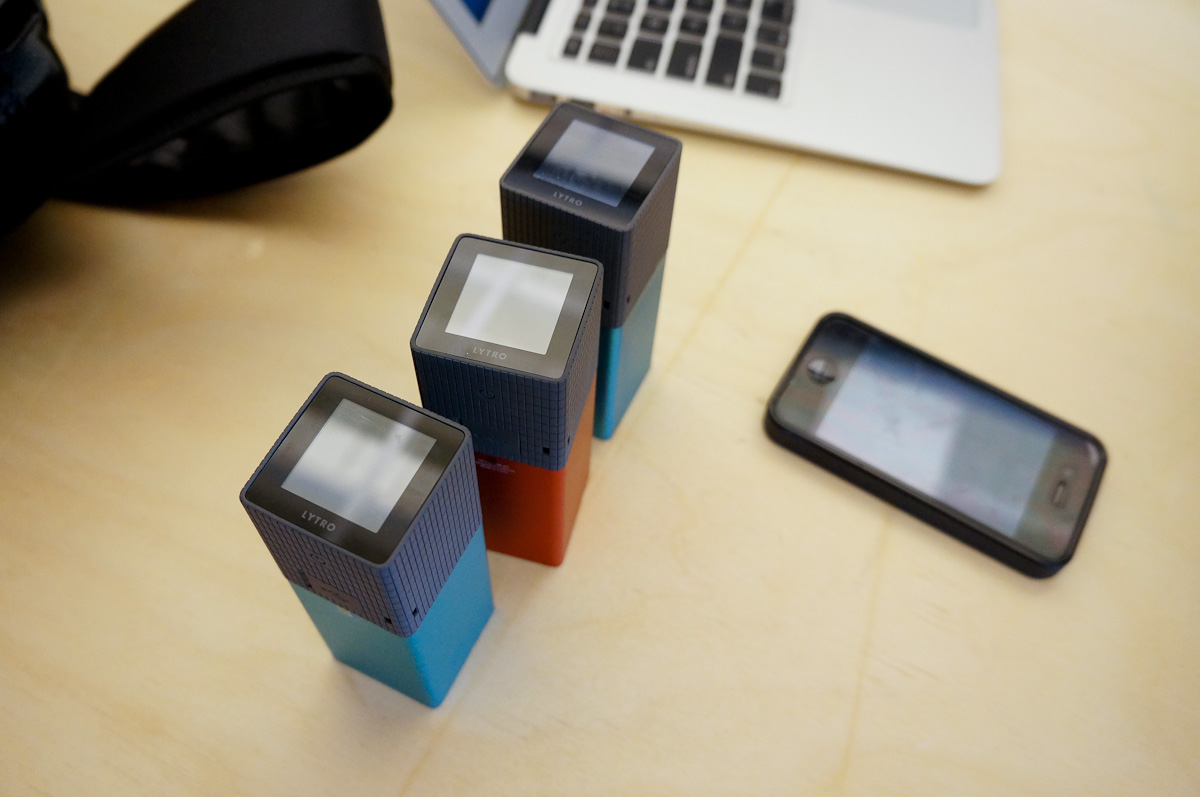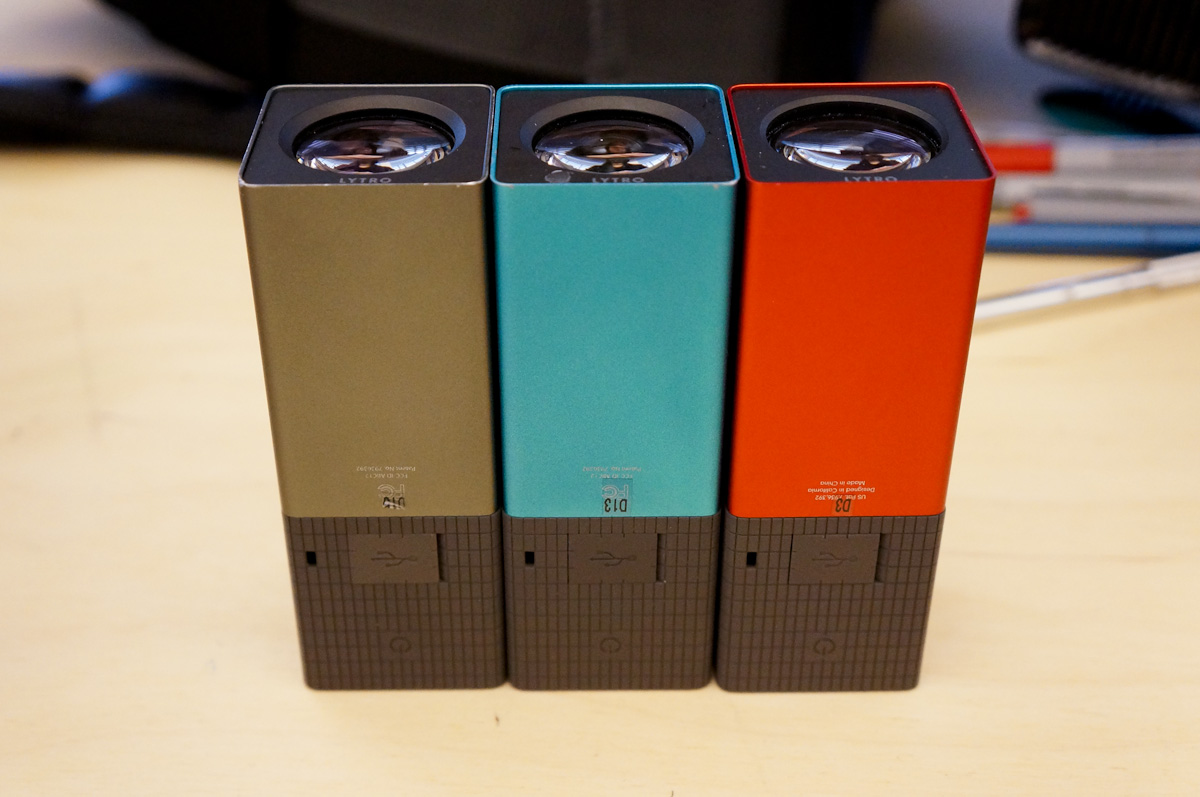 Last week I had the opportunity to take a closer look at the Lytro camera. They were in town to show off their product at the MIT. They followed an invitation to our IDEO studio to get feedback from our creative group. First I have to say that it is an impressive concept. Based on research made at Standford University and further developed to a marketable product by one of their students and company founder Ren Ng, this small camera allows you to post define the focus point. How does it work? Don’t ask me, but basically it captures 16 images within a fraction of time at different focal points. Inside is a moving lens, made of off-the-shelf video lens components, that captures images at a fixed shutter time of 1/200 and a fixed aperture of f2.0. I am not entirely sure how it adjust for light differences. Maybe through ISO adjustment. Once downloaded to your computer you can play with the images and set the focus point at any place. What a great concept for sports photography. Just imagine that you shoot action and later on you define the point of interest. Overall the camera is well made. Anodized aluminum and rubber-molded skins provide a quality feel. The interface is simple, just an on/off button in the rubber skin, a shutter button, a USB connector, and a unique touch-sensitive rubber rim that lets you interact with the menu. No SD card slot, but built in memory of 8 or 16 GB depending on the model. That gives you 350 or 750 images stored inside the camera. The square screen is a touch-screen, which is tiny but big enough to preview and review the shots. The location at the end of the camera makes sense from a aesthetic perspective but it makes you hold the unit like a kaleidoscope. I wish it would be angled or be able to be angled, which would allow me to hold it at a lower position. I assume that the fast development time of this camera didn’t allow for too many mechanical features. It would have driven up complexity and cost. Overall the design is refreshing in a marketplace where more and more new cameras look like old cameras. Its simple, square profile communicates simplicity, playfulness, and quality. The design polarizes and that is good at a time in which most manufacturers look for conformity. So how is the quality of the files? At this point they are good enough for Internet applications and small prints. Lytro has been a bit nebulous about the actual file size, using words like mega-rays to describe the output. I guess that was a marketing decision to be able to compete in a mega-pixel sensitive environment. One mega-pixel is the output per file. That is fine since we don’t need more for small shots that we add to our blogs and profiles. The fact that you can play with the focus and the small file size make this camera a fun tool for the Internet crowd. Personally I like is device. It is, as my friend Jose (pictured below) would say, the first real innovation in camera technology since the digital sensor.
Last week I had the opportunity to take a closer look at the Lytro camera. They were in town to show off their product at the MIT. They followed an invitation to our IDEO studio to get feedback from our creative group. First I have to say that it is an impressive concept. Based on research made at Standford University and further developed to a marketable product by one of their students and company founder Ren Ng, this small camera allows you to post define the focus point. How does it work? Don’t ask me, but basically it captures 16 images within a fraction of time at different focal points. Inside is a moving lens, made of off-the-shelf video lens components, that captures images at a fixed shutter time of 1/200 and a fixed aperture of f2.0. I am not entirely sure how it adjust for light differences. Maybe through ISO adjustment. Once downloaded to your computer you can play with the images and set the focus point at any place. What a great concept for sports photography. Just imagine that you shoot action and later on you define the point of interest. Overall the camera is well made. Anodized aluminum and rubber-molded skins provide a quality feel. The interface is simple, just an on/off button in the rubber skin, a shutter button, a USB connector, and a unique touch-sensitive rubber rim that lets you interact with the menu. No SD card slot, but built in memory of 8 or 16 GB depending on the model. That gives you 350 or 750 images stored inside the camera. The square screen is a touch-screen, which is tiny but big enough to preview and review the shots. The location at the end of the camera makes sense from a aesthetic perspective but it makes you hold the unit like a kaleidoscope. I wish it would be angled or be able to be angled, which would allow me to hold it at a lower position. I assume that the fast development time of this camera didn’t allow for too many mechanical features. It would have driven up complexity and cost. Overall the design is refreshing in a marketplace where more and more new cameras look like old cameras. Its simple, square profile communicates simplicity, playfulness, and quality. The design polarizes and that is good at a time in which most manufacturers look for conformity. So how is the quality of the files? At this point they are good enough for Internet applications and small prints. Lytro has been a bit nebulous about the actual file size, using words like mega-rays to describe the output. I guess that was a marketing decision to be able to compete in a mega-pixel sensitive environment. One mega-pixel is the output per file. That is fine since we don’t need more for small shots that we add to our blogs and profiles. The fact that you can play with the focus and the small file size make this camera a fun tool for the Internet crowd. Personally I like is device. It is, as my friend Jose (pictured below) would say, the first real innovation in camera technology since the digital sensor.  Everything else has just been an improvement but not a radical new step. The potential of the technology goes far beyond. Being able to retrofit pro-cameras with that technology would be huge. It would eliminate the frustrating moments when you look at your monitor and you realize that the focus is off. Adjust it and you are done. Every photographer who needs to shoot fast moving objects dreams about this option. Race cars, kids, weddings, no problems. For Lytro this is a first step to establish themselves as a technology leader and design sensitive company. At the same time they will face a similar position as Foveon. The Foveon sensor inside Sigma cameras eliminates the moire problem that we get from Bayer sensors by stacking red, green, blue readouts on top of each other instead of next to each other. At the same time it leads to great color rendition. Still, it has never made it into a really huge success. People like the technology and the company has a strong following, but they struggle in a market that decided that mega-pixels are the gold standard for image quality. We may witness a first shift. People realizing that they have reached the limit of what they need and and what their computers could handle. That may be a chance for companies like Faveon and Lytro to provide options that are not about ultimate resolution but about image quality or image control. In the end users don’t want to have too many cameras. A smart-phone will be our standard all-around capturing device and some of us will use a few more for professional or ambitious amateur reasons. The success of Lytro will depend on how they can transition from a one-time stand to a serious relationship. Ahh, it’s Valentines Day. The technology is amazing and the camera is interesting in its Gestalt. I want them to be successful and wish them good luck. This camera will ship next month. Check out this link on their website to explore some images and to preorder. $399 or $499 depending on the storage capacity. D!RK
Everything else has just been an improvement but not a radical new step. The potential of the technology goes far beyond. Being able to retrofit pro-cameras with that technology would be huge. It would eliminate the frustrating moments when you look at your monitor and you realize that the focus is off. Adjust it and you are done. Every photographer who needs to shoot fast moving objects dreams about this option. Race cars, kids, weddings, no problems. For Lytro this is a first step to establish themselves as a technology leader and design sensitive company. At the same time they will face a similar position as Foveon. The Foveon sensor inside Sigma cameras eliminates the moire problem that we get from Bayer sensors by stacking red, green, blue readouts on top of each other instead of next to each other. At the same time it leads to great color rendition. Still, it has never made it into a really huge success. People like the technology and the company has a strong following, but they struggle in a market that decided that mega-pixels are the gold standard for image quality. We may witness a first shift. People realizing that they have reached the limit of what they need and and what their computers could handle. That may be a chance for companies like Faveon and Lytro to provide options that are not about ultimate resolution but about image quality or image control. In the end users don’t want to have too many cameras. A smart-phone will be our standard all-around capturing device and some of us will use a few more for professional or ambitious amateur reasons. The success of Lytro will depend on how they can transition from a one-time stand to a serious relationship. Ahh, it’s Valentines Day. The technology is amazing and the camera is interesting in its Gestalt. I want them to be successful and wish them good luck. This camera will ship next month. Check out this link on their website to explore some images and to preorder. $399 or $499 depending on the storage capacity. D!RK
Feb 142012





